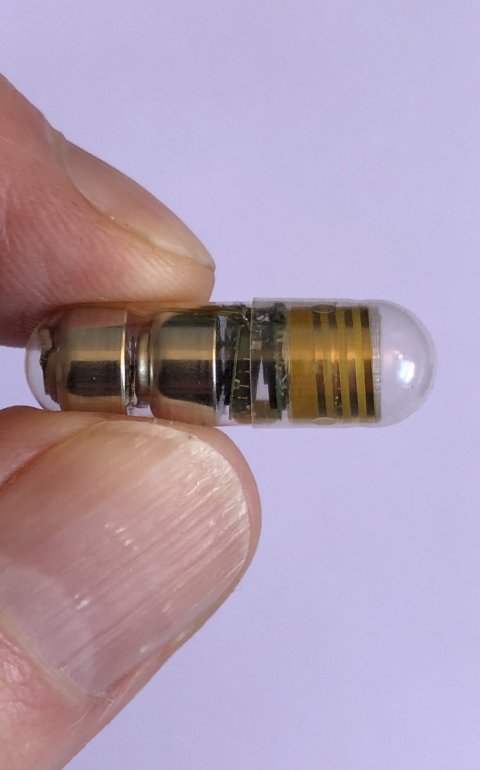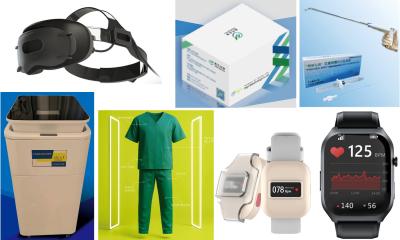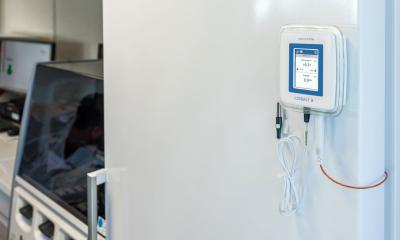News • First human clinical trial
Pill-sized device monitors breathing from the gut
Scientists have developed an ingestible device that can safely monitor vital signs like breathing and heart rate from inside humans.

Image credit: Ben Pless (CC BY-SA 4.0)
The tool, described in the journal Device, has the potential to provide accessible and convenient care for people at risk of opioid overdose.
“The ability to facilitate diagnosis and monitor many conditions without having to go into a hospital can provide patients with easier access to healthcare and support treatment,” says Giovanni Traverso, the first author of the paper, associate professor in the Department of Mechanical Engineering at the Massachusetts Institute of Technology and gastroenterologist at Brigham and Women’s Hospital.
In recent years, scientists have been developing a plethora of ingestible devices. Unlike implantable devices such as pacemakers, ingestible devices are easy to use and do not require a surgical procedure. For example, doctors have been using pill-sized ingestible cameras to conduct colonoscopies, a procedure traditionally conducted in a hospital setting. “The idea of using an ingestible device is that a physician can prescribe these capsules, and all the patient needs to do is to swallow it,” says Benjamin Pless, the paper’s co-author and the founder of the Celero Systems, a medical device developer based in Massachusetts. “People are accustomed to taking pills, and costs of using ingestible devices are much more affordable than performing traditional medical procedures.”
The vitals-monitoring pill, or VM Pill, works by monitoring the small vibrations of the body associated with breathing and the beating heart. The pill can detect if a person stops breathing from the inside of the digestive tract. To test out the pill, the team placed the device in the stomach of pigs which were put under anesthesia. Researchers then administered the pigs with a dose of fentanyl that caused the pig to stop breathing, which is what happens during fentanyl overdose in humans. The device measured the pig’s breathing rate in real time and alerted the researchers, who were able to reverse the overdose.
The ability to remotely monitor critical vital signals from patients without wires, leads, or need of medical technicians, opens the door for monitoring patients in their natural environments versus the clinic or the hospital setting
Ali Rezai
The team also tested the device in humans for the first time by giving the VM Pill to those being evaluated for sleep apnea. Sleep apnea is a disorder in which breathing repeatedly stops and starts during sleep. Many people with the condition remain undiagnosed, in part because diagnosing the condition involves admitting people to a sleep laboratory where they are hooked up to external devices to monitor their vital signs during sleep. “Given our interest in opioid safety, it came to our attention that sleep apnea has a lot of the same symptoms as opioid-induced respiratory depression,” says Pless.
Researchers gave the VM Pill to 10 patients with sleep apnea at West Virginia University. The device was able to detect when the participants’ breathing stopped and to monitor respiration rate with an accuracy of 92.7%. Compared with external vital monitoring machines, the pill can monitor heart rate with an accuracy of at least 96%. The trial also showed the device is safe, and all participants excreted the device in the few days after the experiment. “The accuracy and correlation of these recordings were excellent compared to the clinical gold standard studies we performed in our sleep laboratories,” says Ali Rezai, the paper’s co-author and a neuroscientist at the Rockefeller Neuroscience Institute, West Virginia University. “The ability to remotely monitor critical vital signals from patients without wires, leads, or need of medical technicians, opens the door for monitoring patients in their natural environments versus the clinic or the hospital setting,” he adds.
Traverso says the current version of the VM Pill passes through the body in about a day, but there are modifications they can make to the device in the future that would allow it to stay longer for long-term monitoring. In the future, they also hope to upgrade the device so it can deliver drugs to reverse conditions like opioid overdose automatically once the device detects symptoms. “In the future, there are many situations, including opioid overdose and other respiratory and cardiac conditions, that could certainly benefit from this ingestible device,” Traverso says.
Source: Cell Press
18.11.2023











